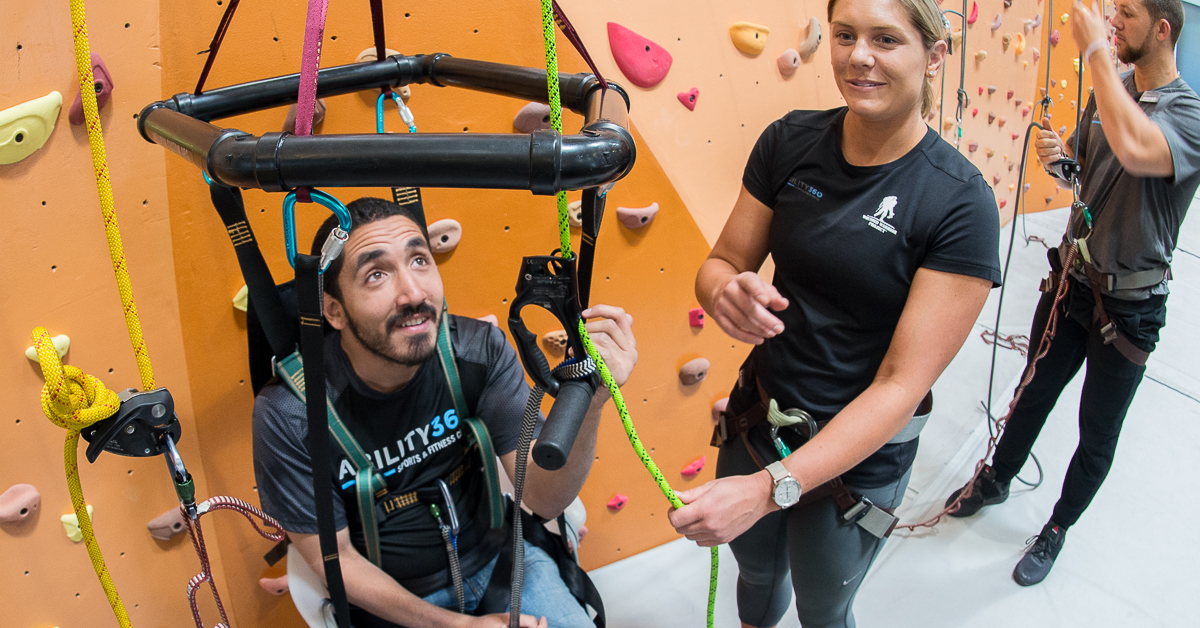We caught up with National Geographic’s 2019 Adventurer of the Year and 2x Para Climbing World Champion, Mo Beck, about how catch-and-hold technology can make auto belays a viable training tool for more adaptive climbers than ever before.
It is, however, our job – as industry professionals, product engineers, and members of the climbing community -- to empower that desire and to improve the climbing experience for as many different people with as many different styles as possible.
We caught up with National Geographic’s 2019 Adventurer of the Year and 2x Paraclimbing World Champion, Mo Beck, about how catch-and-hold technology can make auto belays a viable training tool for more adaptive climbers than ever before. Also called paraclimbing, adaptive climbing makes climbing accessible to people with any type of physical disability.
“Every climber adapts on every route they climb,” said artist and climber Jon Sedor in the video What is Adaptive Climbing?. “It’s very rare, especially for example between different genders, that I see a man and a woman do the same thing. Not because one is any less strong, it’s just different body types.”
Knowing that different bodies move and climb differently, the question becomes: how can we make climbing more inclusive and more accessible for the most people? One way to increase inclusivity is to develop climbing equipment that is useful for climbers who have been previously overlooked and underserved.
Until recently, auto belays were impractical for many adaptive climbers. Seated climbers, for example, could not train on auto belay because instantly lowering after a top out or a fall was too unsteady. With the recent release of the TRUBLUE iQ+, we aim to change that narrative.
The TRUBLUE iQ+ is the first auto belay that allows climbers to stay on the wall after falling, rather than immediately lowering. We call this the “catch-and-hold" feature. In climbing terms, what the TRUBLUE iQ+ is doing is giving you the option to take.
It works like this: when a climber comes off the wall, the TRUBLUE iQ+ catches them, preserving their progress. The device then proceeds to hold them there for up to 30 seconds. For seated climbers, catch-and-hold provides a chance to rest before continuing to climb or to restabilize before lowering.
“I think the TRUBLUE iQ+ is actually an amazing tool for paraclimbing because different athletes with different abilities climb at different speeds,” said Maureen “Mo” Beck, 2x gold medalist at the Paraclimbing World Championships and National Geographic’s 2019 Adventurer of the Year.
Beyond the advantages for seated climbers, Beck called out the catch-and-hold feature of the TRUBLUE iQ+ as being particularly useful for visually impaired climbers. “I think it's going to be huge, especially for our VI blind climbers because they're always stopping to hunt for holds,” Beck explained. “Right now, if they let go, they have to start the entire route over and they're at a loss. But with the TRUBLUE iQ+, they can stop, feel for the holds, and then continue on their way, which is amazing! And to be able to do that, without having a belayer, gives our disabled athletes even more independence to be just a climber.”
Our knowledge is build from over many years of practical experience in adaptive and adventurous sports. Our vision is to improve the provision of inclusive climbing and other disability sports in the adventure activity sector. Our aim is to provide you with the tools and skills to do this.
What is it? Inclusion is….
We define inclusive rock climbing as para-climbing; climbing for people with impairments, disabilities, SEN and/or chronic long-term medical conditions. But inclusion could be required where the activities and/or environments of climbing need to be positive for those with mental health issues and/or supportive for the diversity of individuals.
How can it be done?
How to provide inclusive activities/make rock climbing more inclusive and provide inclusive activities. We are here to help by making climbing and the climbing community more inclusive though assisting and/or creating an environment and activities that provide climbing for all regardless of disability or impairment. Our master plan is to get the knowledge and advice out their and accessible. We do this via publications, training and technical advice on an individuals basis, a climbing wall or rock climbing/adventurous activity.
Modifying their approach allows climbing without limits. People of all abilities, from the visually impaired, amputees, cancer and stroke survivors, have no limits when climbing on the wall. Not only does it give a sense of achievement and renewed confidence, but it also provides an inclusive community to belong to.
Additional expert Information regarding Auto Belay technology
Interested to read more about the Auto Belay technology and expert opinions?
- Why More FECs Trust TRUBLUE Auto Belays
- TRUBLUE iQ+ World's first catch-and-hold auto belay
- Climbing Walls at FECs: ROI Considerations
- Improve the Accessibility and Inclusivity of Your Climbing Gym
- Catch-and-Hold: What is it and how does it work?
- Climbing on Auto Belay: What You Need to Know
- Our Auto Belay Maintenance Program
- 7 Ways Magnetic Braking Is Better Than Friction
- A Kid’s Guide to Gym Climbing
- Climb Safe, Climb Smart: Understanding the Auto Belay Device
- 5 Ways TRUBLUE Can Help a Climbing Gym
- Auto-Belay and hands-free climbing challenges
- Auto Belay for Speed Climbing
- Speed climbing is becoming more popular then ever
- 5 unique ways to use an auto belay
- Trustworthy and Consistent Climbing Protection
- Auto belay retraction systems white paper













